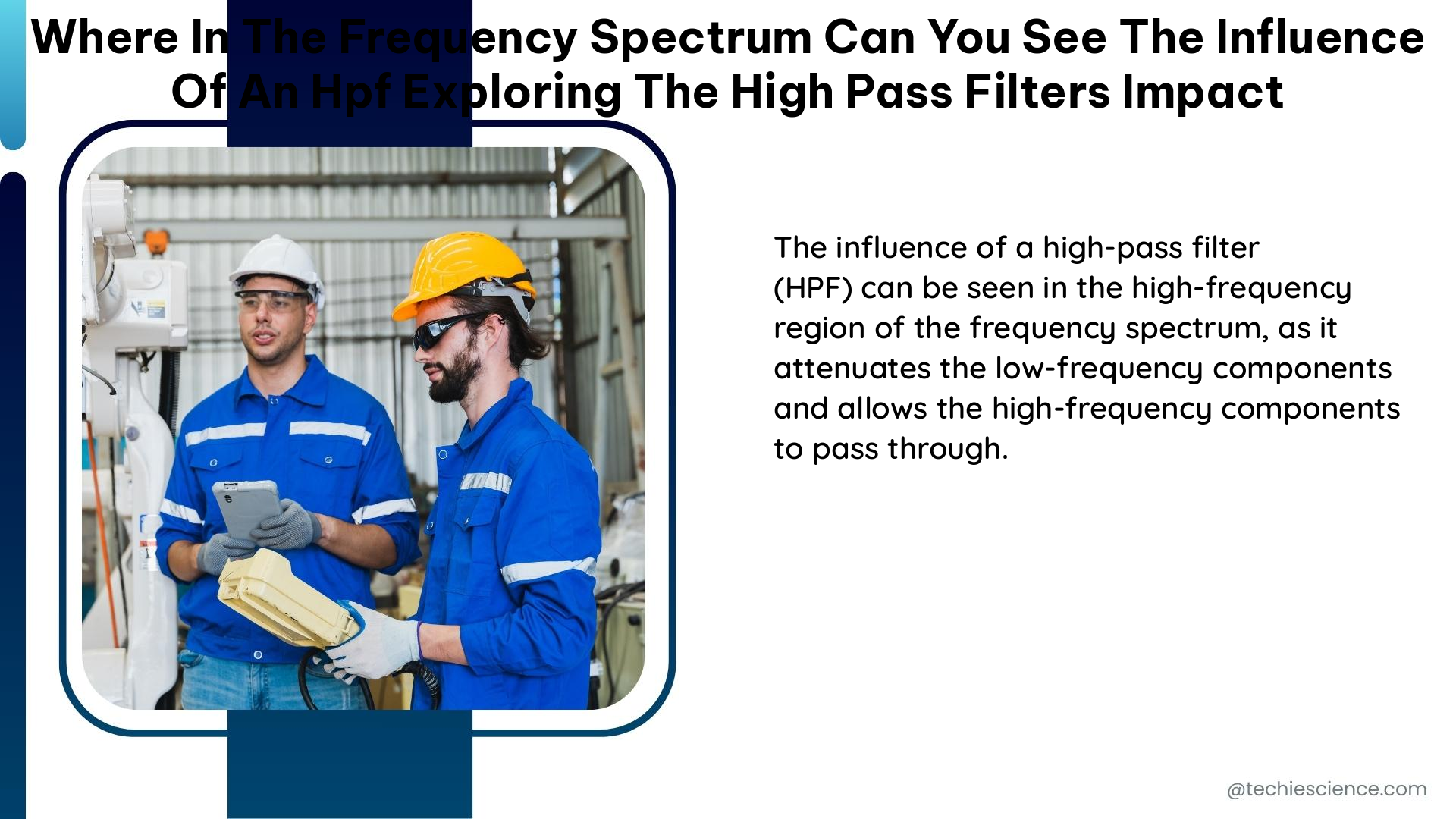The influence of a High Pass Filter (HPF) on the frequency spectrum is a crucial aspect of audio signal processing and electronic circuit design. By understanding where in the frequency spectrum the impact of an HPF can be observed, engineers and audio professionals can effectively utilize these filters to achieve their desired audio characteristics.
Cutoff Frequency and Attenuation
The primary influence of an HPF can be seen in the attenuation of frequencies below the cutoff frequency. The cutoff frequency is the point at which the filter begins to attenuate, or reduce, the signal. This attenuation is typically measured in decibels (dB) and can be plotted on a frequency response graph.
For example, if an HPF has a cutoff frequency set at 100 Hz, we would expect to see a significant attenuation of frequencies below 100 Hz. The rate of attenuation is determined by the slope of the filter, which is often adjustable. Common slope values are 6 dB, 12 dB, 18 dB, and 24 dB per octave. The higher the slope, the steeper the attenuation curve will be.
| Cutoff Frequency | Slope | Attenuation at 50 Hz (1 octave below) | Attenuation at 25 Hz (2 octaves below) |
|---|---|---|---|
| 100 Hz | 6 dB | -6 dB | -12 dB |
| 100 Hz | 12 dB | -12 dB | -24 dB |
| 100 Hz | 18 dB | -18 dB | -36 dB |
| 100 Hz | 24 dB | -24 dB | -48 dB |
As shown in the table, the attenuation of frequencies below the cutoff frequency is directly related to the slope of the HPF. A steeper slope, such as 24 dB per octave, will result in a more aggressive attenuation of low frequencies compared to a gentler slope of 6 dB per octave.
Practical Applications of HPFs

In practical terms, an HPF can be used to remove low-frequency noise or rumble from an audio signal, while preserving the higher frequencies. This can be particularly useful in situations where the signal contains unwanted low-frequency energy, such as traffic noise, wind noise, or electrical hum.
For example, if a microphone is placed near a busy street, it may pick up low-frequency rumble from passing vehicles. By applying an HPF with a cutoff frequency of, say, 80 Hz and a slope of 12 dB per octave, the engineer can effectively attenuate the unwanted low-frequency noise while maintaining the desired audio content.
Measuring the Impact of an HPF
To measure the impact of an HPF, engineers and audio professionals can use a spectrum analyzer or other measurement tools to visualize the frequency response of the signal before and after the filter is applied. This allows them to see exactly where in the frequency spectrum the attenuation is occurring and to what degree.
For example, if an HPF with a cutoff frequency of 100 Hz is applied to a signal that contains energy at 50 Hz, we would expect to see a significant reduction in the level of the 50 Hz component. The exact amount of reduction will depend on the slope of the filter and the level of the signal at 50 Hz.
By analyzing the frequency spectrum, engineers can fine-tune the HPF settings to achieve the desired audio characteristics. They can adjust the cutoff frequency to target specific frequency ranges and the slope to control the rate of attenuation.
Frequency Spectrum Analysis Tools
There are various tools and software available for analyzing the frequency spectrum and the impact of HPFs. Some popular options include:
-
Spectrum Analyzers: Dedicated hardware spectrum analyzers, such as those from Tektronix, Rohde & Schwarz, and Keysight, provide precise and detailed frequency domain measurements.
-
Digital Signal Processing (DSP) Software: Software like MATLAB, LabVIEW, and Python-based libraries (e.g., NumPy, SciPy) offer powerful tools for digital signal processing and frequency spectrum analysis.
-
Audio Editing and Mixing Software: Programs like Pro Tools, Logic Pro, and Ableton Live often include built-in spectrum analyzers and tools for visualizing the frequency response of audio signals.
-
Online Tools: There are also web-based tools, such as the Bode Plot Generator from CircuitLab, that allow you to simulate and analyze the frequency response of electronic circuits, including HPFs.
By leveraging these tools, engineers and audio professionals can gain a deeper understanding of the impact of HPFs on the frequency spectrum, enabling them to make informed decisions and optimize their audio processing workflows.
Conclusion
The influence of a High Pass Filter (HPF) on the frequency spectrum is a crucial aspect of audio signal processing and electronic circuit design. By understanding the relationship between the cutoff frequency, slope, and attenuation, engineers and audio professionals can effectively utilize HPFs to achieve their desired audio characteristics.
Through the use of spectrum analyzers, DSP software, and other measurement tools, they can visualize the frequency response of signals before and after the application of an HPF, allowing them to fine-tune the filter settings and optimize their audio processing workflows.
By mastering the concepts and techniques presented in this guide, you can become a more proficient and versatile engineer or audio professional, capable of leveraging the power of High Pass Filters to shape and refine your audio signals with precision and confidence.
References
- 6 Ways to Use a High-Pass Filter When Mixing
- Understanding High-Pass Filters
- High-pass filter
- Bode Plot Generator

The lambdageeks.com Core SME Team is a group of experienced subject matter experts from diverse scientific and technical fields including Physics, Chemistry, Technology,Electronics & Electrical Engineering, Automotive, Mechanical Engineering. Our team collaborates to create high-quality, well-researched articles on a wide range of science and technology topics for the lambdageeks.com website.
All Our Senior SME are having more than 7 Years of experience in the respective fields . They are either Working Industry Professionals or assocaited With different Universities. Refer Our Authors Page to get to know About our Core SMEs.